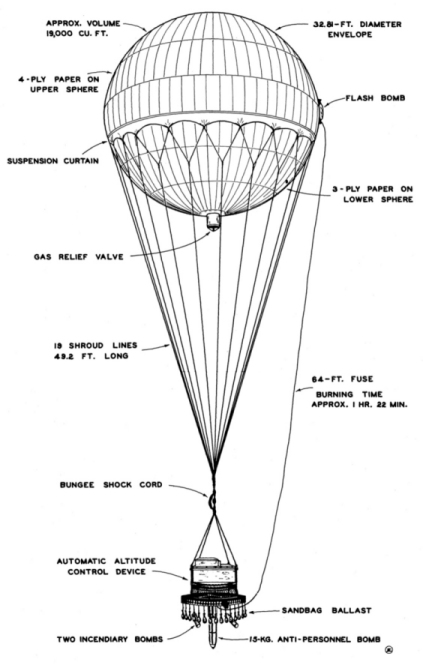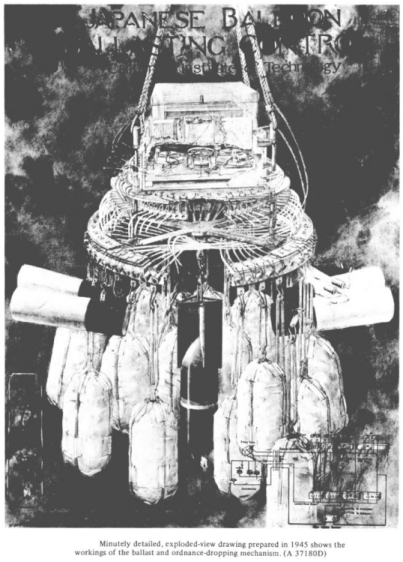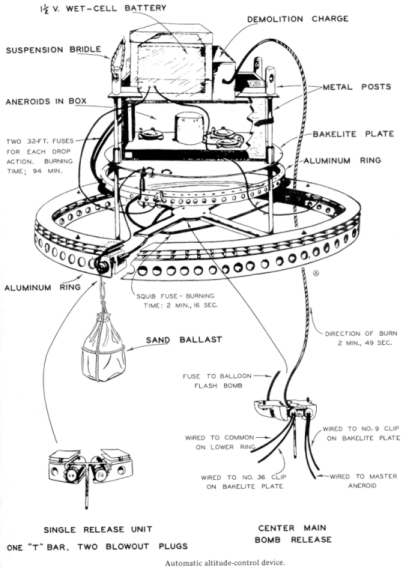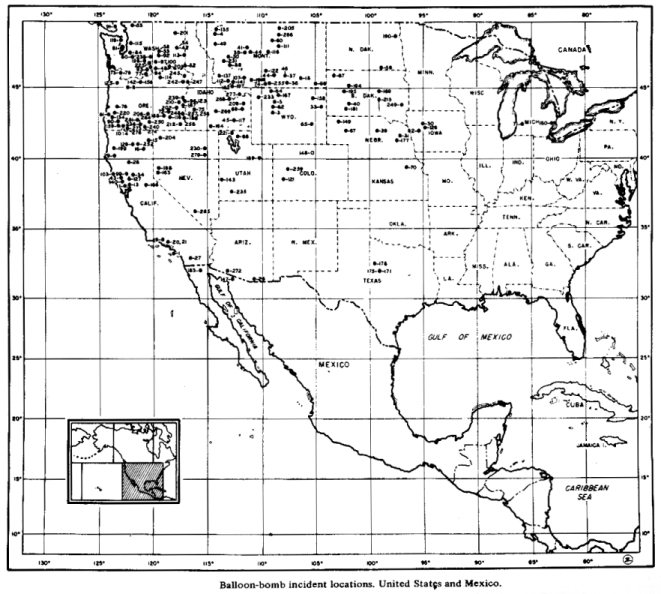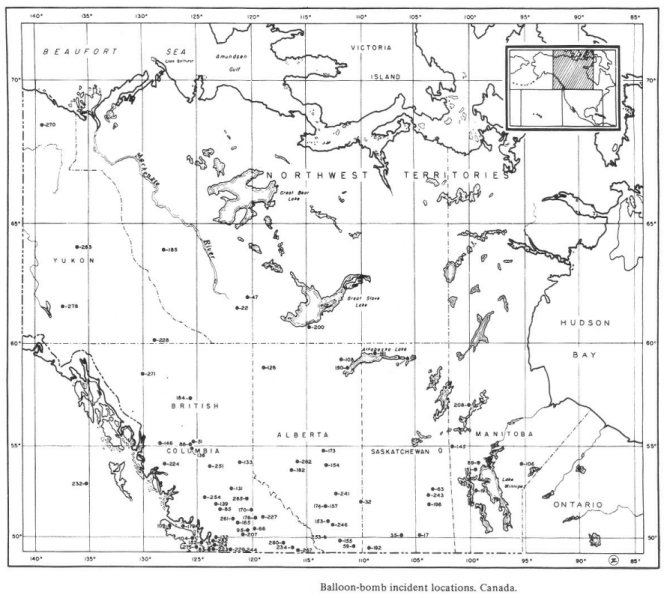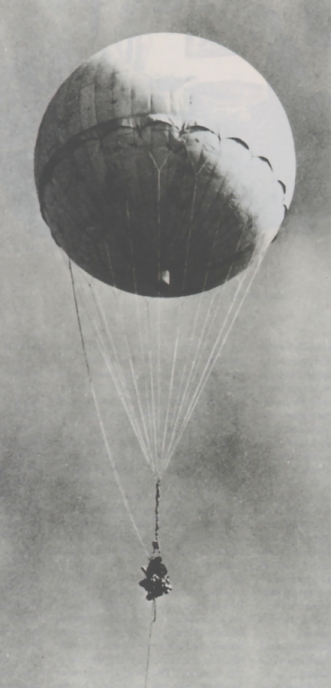How Geologists Unraveled the
Mystery of Japanese
Vengeance
Balloon Bombs in World War II
J. David Rogers, Ph.D.,
P.E., R.G.,C.E.G., C.HG.
Karl F. Hasselmann Chair in Geological Engineering
Department of Geological Sciences & Engineering
Missouri University of Science & Technology
129 McNutt Hall, 1400 N. Bishop Ave.
Rolla, MO 65409-0230
During the Second World War the Japanese conceived the idea of fashioning incendiary bombs and attaching these to balloons which were released with easterly wintertime jet stream winds above 30,000 feet to float 5,000 miles across the north Pacific. The idea was to have these devices explode over the forested regions of the Pacific Northwest and initiate large forest fires that would hopefully divert U.S. manpower from warfighting in the Pacific theater to combating fires at home.
The balloons were crafted from mulberry paper, glued together with potato flour and filled with expansive hydrogen. They were 33 feet in diameter and could lift approximately 1,000 pounds, but the deadly portion of their cargo was a 33-lb anti-personnel fragmentation bomb, attached to a 64–foot long fuse that was intended to burn for 82 minutes before detonating. The Japanese programmed the balloons to release hydrogen if they ascended to over 38,000 feet and to drop pairs of sand filled ballast bags if the balloon dropped below 30,000 feet, using an onboard altimeter. Three-dozen sand-filled ballast bags were hung from a 4-spoke aluminum wheel that was suspended beneath the balloon, along with the bomb. Each ballast bag weighed between 3 and 7 pounds. The bags were programmed to be released in pairs on opposing sides of the wheel so the balloon would not be tipped to one side or another, releasing any of the precious hydrogen. In this way the balloons would rise in the daylight heat each day of the crossing and fall each evening, till their ballast bags were depleted, at which time the balloon and its deadly contents would descend upon whatever lay beneath it.
The first balloons were launched on November 3, 1944 and began landing in the United States on November 5th (off San Pedro, California) and by the following day (November 6th) were landing as far away as Thermopolis, Wyoming. 285 confirmed landings/sightings were made over a wide area, stretching from the Aleutian Islands, Canada and across the width and breadth of the continental United States: as far south as Nogales, Arizona (on the Mexican border) and easterly, to Farmington, Michigan (10 miles from Detroit). Most of the ballast bags were released in the trip across the north Pacific, but a few balloons crashed without exploding and some of the ballast bags were recovered. All of the bags contained the same type of dark colored sand.
The U.S. government muzzled the media about making any mention of the balloons in fear that whoever was producing them might be encouraged to send more. On March 5, 1945 a minister’s wife and five Sunday School students on a fishing trip were killed by one of the grounded balloons near Bly, Oregon while attempting to pull it through the forest, back to their camp. These were the only casualties of the balloon bombs during the war and the victim’s relatives were provided with a special death benefit after the war ended (in March 1946). The American public was made aware of the balloons after these tragic deaths, but word of their detonation never filtered back to the Japanese.
The Military Geology Unit (MGU) of the U.S. Geological Survey was tasked with investigating the small handfuls of sand occasionally recovered from the various crash sites. Before they were engaged in the solving the case federal investigators believed that the balloons were either being fashioned in POW camps along the west coast or possibly being released from Japanese submarines off our coast. On initial examination the MGU quickly eliminated North America as a source of the sand. The sand contain over 100 species of tiny microscopic diatoms, a mixture of fossil and recent species. There are 25,000 recognized species of diatoms. The fossil diatoms were all found to be of Pliocene age, between 5.3 and 1.6 Ma (million years before present).
It was immediately clear that the ballast sand had come from a beach, but where? Further examination revealed that the sand was devoid of any coral, but contained small mollusk fragments. In Japan coral grows along the coast of the main island of Honshu as far north as Tokyo Bay, near the 35th Parallel. They also found foraminifera (known as “forams”), tiny skeletons of microscopic organisms that feed on the ocean bottom. Some of the foram species identified had only been previously described in Japanese geologic papers dealing with beaches north of Tokyo on the eastern shore of Honshu.
The individual sand grains were found to be of granitic origin, but with an unusual set of trace, or associated, minerals. 52% of those trace minerals were hypersthene, a heavy mineral. Another mineral called augite was also found in abundance, but was known to be of volcanic origin. Two other heavy minerals, hornblende and garnet, were varieties thought to be associated with metamorphic source rocks. By now the MGU geologists had narrowed the source area to the northerly thousand miles of Japan’s eastern coasts. Further detailed study of pre-war Japanese geologic studies allowed them to narrow the source area by 80%. They determined that the sand samples likely came from either of two locations: a northerly site along the great beach at Shiogama, close to Sentai, Japan; and/or the Ninety-nine League Beach at Ichinomiya, Japan.
The work of the MGU conclusively identified northeastern coastal Japan as the source area for the sand ballast, and the likely point of launching. Once these locations were revealed detailed photo reconnaissance were made of the areas in early 1945 and the photo interpreters succeeded in identifying two of the three plants producing hydrogen for the project in vicinity of Ichinomiya. These plants were conclusively destroyed by American B-29 bombers based in the Mariannas Islands in April 1945, putting an end to the vengeance bomb project.
Although only 285 of the 9,000 bomb-laden balloons the Japanese launched were documented to have reach North America, experts believe that probably close to 1,000 made it across the Pacific. The Japanese government withdrew further funding for the project around the same time (April 1945) allied bombers destroyed the hydrogen plants, due to lack of conclusive evidence that they were reaching America and exploding. After the war, intelligence debriefings of those responsible for the launchings revealed that the balloons had been launched from three sites: Ichinomiya (close to Tokyo) and two other sites 10 miles apart and about 100 miles up the coast of Honshu, in the direction of Shiogama. The MGU hadn’t identified the two northerly launch sites because the only sand samples they were provided with had come from Ichinomiya. Forensic geology became a permanent part of the Federal Bureau of Investigation and continues to help solve difficult mysteries to the present.
Figures:
A Japanese 10-meter diameter Mulberry paper
balloon re-inflated at NAS Moffett Field, CA following its downing
by a Navy aircraft about 30 miles west of Alturas,
CA on January 10, 1945 (US Army photo A 37180C).
This balloon now belongs to the National Air and Space Museum.
Additional reading:
McPhee, John, 1996, Balloons of War, in The Gravel Page: The New Yorker (magazine), v. 71, n. 46, January 29, 1996, p. 52-60.
Mikesh, Robert C., 1978, Japan's World War II Balloon Bomb Attacks on North America: Smithsonian Institute Press, National Air and Space Museum, Wash., D.C., 85 pages.
Webber, Bert, 1992, Silent Siege III: Japanese Attacks on North America in World War II: Webb Research Group, Medford, 398 p.
There are dozens of interesting websites describing
the Japanese balloon bombs. Suggest you have students go to a search engine
and type: “Japan”+”balloon bombs”
Questions or comments on this page?
E-mail Dr. J David Rogers at rogersda@mst.edu.
